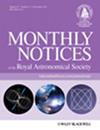Short-lived gravitational instability in isolated irradiated discs
IF 4.8
3区 物理与天体物理
Q1 ASTRONOMY & ASTROPHYSICS
引用次数: 0
Abstract
Irradiation from the central star controls the temperature structure in protoplanetary discs. Yet simulations of gravitational instability typically use models of stellar irradiation with varying complexity, or ignore it altogether, assuming heat generated by spiral shocks is balanced by cooling, leading to a self-regulated state. In this paper, we perform simulations of irradiated, gravitationally unstable protoplanetary discs using 3D hydrodynamics coupled with live Monte-Carlo radiative transfer. We find that the resulting temperature profile is approximately constant in time, since the thermal effects of the star dominate. Hence, the disc cannot regulate gravitational instabilities by adjusting the temperatures in the disc. In a 0.1M⊙ disc, the disc instead adjusts by angular momentum transport induced by the spiral arms, leading to steadily decreasing surface density, and hence quenching of the instability. Thus, strong spiral arms caused by self-gravity would not persist for longer than ten thousand years in the absence of fresh infall, although weak spiral structures remain present over longer timescales. Using synthetic images at 1.3mm, we find that spirals formed in irradiated discs are challenging to detect. In higher mass discs, we find that fragmentation is likely because the dominant stellar irradiation overwhelms the stabilising influence of PdV work and shock heating in the spiral arms.孤立辐照圆盘中的短暂引力不稳定性
来自中心恒星的辐照控制着原行星盘的温度结构。然而,对引力不稳定的模拟通常使用复杂程度不同的恒星辐照模型,或者完全忽略它,假设螺旋冲击产生的热量被冷却所平衡,从而导致自我调节状态。在本文中,我们利用三维流体力学和实时蒙特卡洛辐射传递对辐照的、引力不稳定的原行星盘进行了模拟。我们发现,由于恒星的热效应占主导地位,由此产生的温度曲线在时间上近似恒定。因此,圆盘无法通过调整盘内温度来调节引力不稳定性。在 0.1M⊙ 圆盘中,圆盘会通过旋臂引起的角动量传输进行调节,导致表面密度稳步下降,从而熄灭不稳定性。因此,在没有新的内坠的情况下,由自重力引起的强螺旋臂不会持续超过一万年,尽管在更长的时间尺度上仍然存在弱螺旋结构。利用 1.3 毫米的合成图像,我们发现在辐照圆盘中形成的螺旋很难被探测到。在质量较高的圆盘中,我们发现很可能会出现碎裂,因为主要的恒星辐照压倒了螺旋臂中 PdV 工作和冲击加热的稳定影响。
本文章由计算机程序翻译,如有差异,请以英文原文为准。
求助全文
约1分钟内获得全文
求助全文
来源期刊

Monthly Notices of the Royal Astronomical Society
ASTRONOMY & ASTROPHYSICS-
CiteScore
9.10
自引率
37.50%
发文量
3198
审稿时长
3 months
期刊介绍:
Monthly Notices of the Royal Astronomical Society is one of the world''s leading primary research journals in astronomy and astrophysics, as well as one of the longest established. It publishes the results of original research in positional and dynamical astronomy, astrophysics, radio astronomy, cosmology, space research and the design of astronomical instruments.
 求助内容:
求助内容: 应助结果提醒方式:
应助结果提醒方式:


